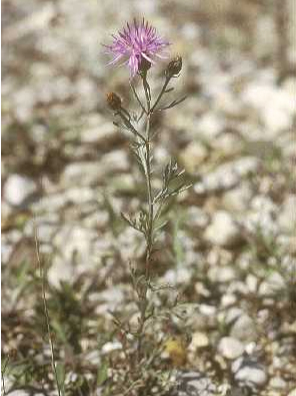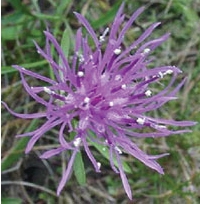Description
Spotted Knapweed is a biennial, or a short-lived perennial, and a member of the Asteraceae family. It typically grows 3-4 feet tall with a majority of the stem growth during the month of June. The basal leaves are arranged in a rosette and are very deeply lobed, whereas the leaves on the stems are arranged alternately and appear more “bract-like.” Spotted Knapweed flowers from June through August with pinkish-purple, thistle-like flowers; each flower is about ¾” in diameter and occurs at the tip of terminal or auxiliary stems. Each flower head has stiff bracts with fine vertical streaks and tips with dark, comb-like fringes. This gives the flower a “spotted” appearance. The seeds of Spotted Knapweed are less than ¼” in length and have a small tuft of bristles at the tip which helps it get disbursed by the wind.

Control Methods
Spotted knapweed can be controlled using a couple methods. It can be manually dug up at the roots, removing all the soil from the root system, and propping it on a log or rock to dry out. This can be done anytime you spot a rosette or adult plant with upright stems. Once the plant has produced any flowering parts (flower or seed), the flowers and/or seeds should be cut from the plant and then placed into a garbage bag to ensure the seeds don’t spread. After that, the rest of the plant can be dug up and placed out to dry. Mowing of Knapweed isn’t very effective because flowers and seeds will develop below the mowing height.
Another effective method is using an herbicide with the active ingredient glyphosate (RoundUp and Glyfos as two examples). It is best to do a spot treatment (spraying individual plants), as opposed to broadcast spraying (spraying the whole area, including native plants) before the plant has produced any flowers. Remember to always follow the herbicide label directions for proper usage.
Ecological Threat
Spotted Knapweed is classified as a “Restricted” invasive in Wisconsin. This means it is currently established in the state and causes, or has the potential to cause, significant environmental or economic harm or harm to human health. It is important to remove Spotted Knapweed because it can very quickly dominate habitats at the expense of plant community diversity. It does this by rapid seed production (on average 1,000 seeds per plant) and by being poisonous to other plants growing nearby (Allopathic). It has also shown to increase surface run-off and sedimentation.
If you want to learn more about identifying or controlling Spotted Knapweed or other invasive plants found in the Menomonee Valley, join me for Work Outside Wednesdays (every Wednesday year-round) from 1-3pm or Flora Fridays (every Friday May-August) 2-4pm.
Photo credit: Wisconsin Department of Natural Resources (WDNR)




